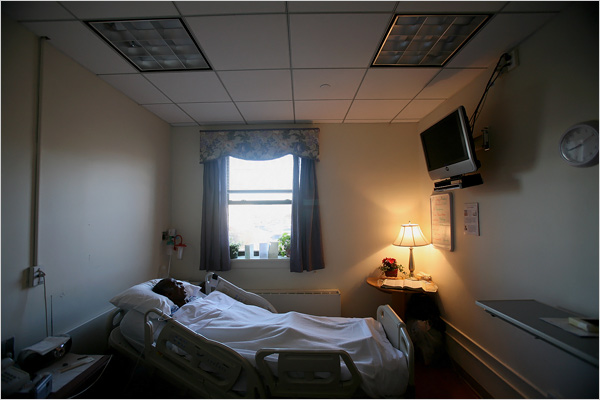
There is much to say – both good and not-so – about last Sunday’s (December 27) NY Times front page article on palliative sedation (“Hard Choice for a Comfortable Death: Drug-Induced Sleep“). The issue is provocatively presented with an inconsistent, but clear insinuation that something may be amiss. I wonder what you all think; however, I am most concerned about the photos(Photos: Ozier Muhammad/The New York Times) which may easily be taken in, without the benefit of reading the explicating text. Front page: “Frank Foster, sleeping under sedation to relieve pain and other effects of liver cancer…” He’s all alone, no one at his bedside. One may wonder, is he being drugged to death and left to die? The article continues further on in section one, on 2 full pages. Three large photos on the first of those pages are of Gloria Scott, an African American “terminal cancer patient” being attended by a white doctor. In one of the photos Ms Scott is being handed a pen by that physician to sign a “do not resuscitate” order. The caption below that one, in the NYT online photo gallery, reads “At first Ms. Scott fiercely resisted signing a ‘do not resuscitate’ order, but in late November, she changed her mind and signed one with Dr. Shaiova.” The 3rd of these pictures is of Ms Scott asleep or in coma; the caption reads: “Early this month she was near death; her doctors said later they believed the drugs had not hastened her end.” Do we believe that? These photos beg some uncomfortable questions: Has this woman made an informed set of choices, and without undue influence? The reader/observer is left wondering: Has she pushed, however subtly, into the ‘no code,’ the ‘terminal sedation’?
We should problematize “palliative sedation” (as Alex Smith, Patrice Villars, and I attempted to do in a recent Lancet article). In fairness to the author of this NY Times article, she does point out that physicians and other hospice workers, as well as ethics committees, are working to develop clear guidelines and policies regarding this practice. But, in the article, there is also hand-wringing over it, and incomplete arguments both for and against the various forms (not fleshed out) of ‘palliative sedation’ … and then those photos. It leaves the reader unsure what to think – befuddled, perhaps … or suspicious. Re people who use the acceptability of palliative sedation as an argument for the acceptance of euthanasia, Joseph Fins is quoted as saying: People who adopt this argument say, “We know what you’re really doing, it’s crypto-euthanasia. Polemics really have no place at the bedside.” Disputatious argumentation at the bedside, no. But clear and cogent arguments regarding how we are treating people who are suffering at the end of life, yes.



